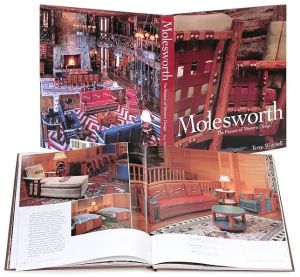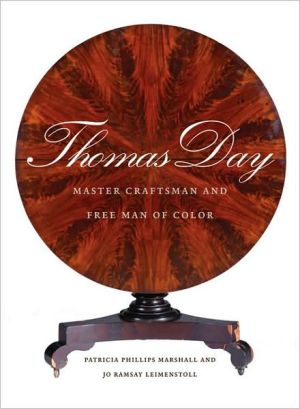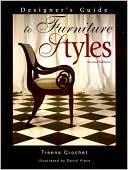Molesworth: The Pioneer of Western Design
Molesworth: Pioneer of Western Design is the quintessential monograph of the legendary Thomas Molesworth, his life and work. As the first thoroughly detailed and complete guide, it explores Molesworth's journey to becoming one of the leading western furniture designers. \ Molesworth's innovative designs-his sense of balance, simplicity, and artfulness-are visible in all of his efforts. In addition to furniture, he designed lighting, floor treatments, and art to complete his concept of a true...
Search in google:
Thomas Molesworth, were he alive today, would be both proud and amazed at the influence his Shoshone Furniture Company and the Cody artists' colony he inspired would have on his old hometown and the Western Design movement seventy-two years after he started producing furniture. Based on nearly two decades of buying, selling, pursuing, and researching Molesworth furniture, Terry Winchell has created a definitive book that covers all spectrums of Molesworth's work, including the influence of the other artists who made his style unique, as well as stylistically and financially successful. The fact that Molesworth's furniture career spanned thirty-plus years speaks for itself. An excellent guide for collectors of Molesworth's work, this book is also an invaluable resource for fans of the Western Design movement. Just as Gustav Stickley was influenced by John Ruskin and William Morris, Molesworth was certainly influenced by the Stickleys and others in the Arts and Crafts movement. Molesworth's early training at the Art Institute of Chicago as well as the influence of the Arts and Crafts movement are apparent in the simplicity and balance of his designs--yet he went a step further by using silhouettes, bright colors, and Native American motifs to personalize his efforts. He was not satisfied to stop there, however. Molesworth showcases furniture on display at the Buffalo Bill Historic Center (Cody, WY), the Museum of the American West (Los Angeles, CA), the Bear Butte Visitors' Center (Sturgis, SD), and Yawkay Plantation (Georgetown, SC), among many other locations.Chapters cover Molesworth's career, education, and the development of his furniture company. Terry Winchell has dealt in antiques for more than twenty-four years as owner of Fighting Bear Antiques in Jackson Hole, Wyoming. He is a recognized authority on rustic and Thomas Molesworth furniture, has performed museum appraisals for the Buffalo Bill Historical Center in Cody, Wyoming, and has consulted for the John Toomey Gallery in Chicago and Christie's in New York. Winchell has been published in Architectural Digest, Art & Antiques, and Cowboys & Indians, and has been featured on HGTV, the BBC, and Antiques Roadshow. Most recently, Winchell was a featured speaker at the Third Annual Arts and Crafts Weekend Conference and Show in Anaheim, California. He graduated from the University of Nebraska with a degree in business administration.Library JournalWith its burled features, Chimayo weavings, and routed wood embellishments, designer Thomas Molesworth's furniture epitomizes a rustic Western style. Molesworth's designs spread throughout the country by word of mouth from those who visited the guest ranches and hotels he furnished. In historic photographs as well as through an abundance of color photos of individual pieces and depicting his work in situ, Winchell, an authority on rustic furniture, chronicles Molesworth's commissions, furniture-making competitors, and the contemporary designers who were influenced by his designs. First-time author Marx features the works of two such craftsmen-furniture makers Jimmy Covert and Marc Taggart-who have incorporated the details of furniture makers like Molesworth but with a contemporary or eclectic look. Also featured are furniture makers, metalworkers, decorative accessories designers, architects, and interior designers whose work is shown in color photographs with informative captions. Both books are recommended where there is interest. Copyright 2005 Reed Business Information.
Little did Tom Molesworth know in 1933 when he moved his family to Cody, Wyoming, what an impact his life would have on the future of Cody and the Western Design movement. Were he alive today, he would be both proud and amazed at the influence of his Shoshone Furniture Company and the Cody colony of artists he inspired, some seventy-two years after he started producing furniture. \ As a historian of his work as well as a collector and dealer, I am amazed at how quickly he developed his style-from his early almost-primitive efforts to his later sleek, comfortable, and professionally stylish approach to furniture-in a matter of four to five years. This speaks of his evolving, innovative designs, his unique use of native materials along with his sense of great balance, comfort, art, and humor. He indeed was incredible at creating remarkable furniture, developing very successful marketing sources from coast-to-coast, and supplying an important client base with western fantasy.\ Molesworth's early training at the Chicago Institute of Art as well as the influence of the Arts and Crafts movement are apparent in the simplicity and balance of his designs-yet he went further by using silhouettes, bright colors, and Native American motifs to personalize his efforts. He also somehow found time to design lighting, floor treatments, and art as well as incorporate artifacts to complete his concept of a true "western space."\ Little did I know that when I got a call from the executor of the Hunter Hereford Ranch in Jackson, Wyoming, in June of 1995 that it would be the beginning of an exciting and sometimes wild ride. I remember to this day the excitement and interest that was aroused in me when I first walked into that great log lodge with its Molesworth furniture, Navaho rugs, and striking view of the Grand Teton in Jackson Hole Valley. At the time, I knew nothing of Thomas Molesworth, but that day my education started.\ Bill Hunter, who had made a small fortune in the auto parts business during the war, and his wife, Eileen, lived in California shortly after World War II. They had visited Jackson Hole a few times where they, as many before and after them, became enchanted with Wyoming and the West. They soon purchased the local Ford dealership, as well as the majestic piece of property, which would soon become the Hunter Hereford Ranch. They hired local log builder Wesley Fox to build the lodge, guest cabin, and huge barn, complete with bar and dance floor. When it came to furnishing the lodge, they went to the Gump's Department Store in San Francisco where they fell in love with a display of furniture by none other than Thomas Molesworth's Shoshone Furniture Company in Cody, Wyoming.\
AcknowledgmentsThe Beginning of the Cody StyleFurniture Becomes ArtGreat Clients and Great CommissionsThe War Years and Competition from WithinFurnishing the WestThe New Collectors and New CollectionsThe New Forces in Western DesignMolesworth's Legacy
\ Library JournalWith its burled features, Chimayo weavings, and routed wood embellishments, designer Thomas Molesworth's furniture epitomizes a rustic Western style. Molesworth's designs spread throughout the country by word of mouth from those who visited the guest ranches and hotels he furnished. In historic photographs as well as through an abundance of color photos of individual pieces and depicting his work in situ, Winchell, an authority on rustic furniture, chronicles Molesworth's commissions, furniture-making competitors, and the contemporary designers who were influenced by his designs. First-time author Marx features the works of two such craftsmen-furniture makers Jimmy Covert and Marc Taggart-who have incorporated the details of furniture makers like Molesworth but with a contemporary or eclectic look. Also featured are furniture makers, metalworkers, decorative accessories designers, architects, and interior designers whose work is shown in color photographs with informative captions. Both books are recommended where there is interest. Copyright 2005 Reed Business Information.\ \






